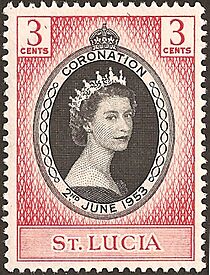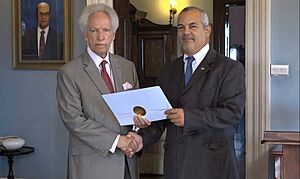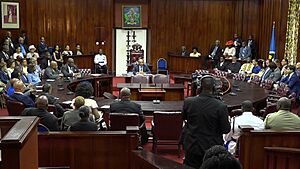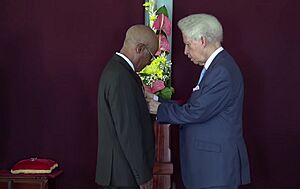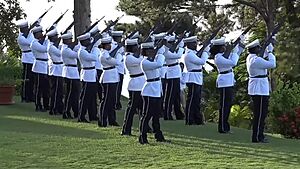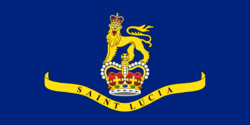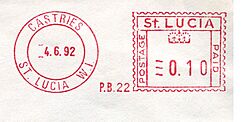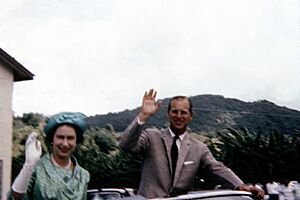Monarchy of Saint Lucia facts for kids
Quick facts for kids King of Saint Lucia |
|
|---|---|

Coat of arms of Saint Lucia
|
|
| Incumbent | |
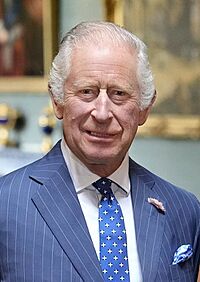 |
|
| Charles III since 8 September 2022 |
|
| Details | |
| Style | His Majesty |
| Heir apparent | William, Prince of Wales |
| First monarch | Elizabeth II |
| Formation | 22 February 1979 |
The monarchy of Saint Lucia is a special way Saint Lucia is governed. It means a king or queen is the country's head of state. This role is passed down through their family. Since September 8, 2022, King Charles III has been the King of Saint Lucia. He represents the country's highest authority.
Even though King Charles III is also the monarch of 14 other countries, Saint Lucia's monarchy is its own. This means he is officially called the King of Saint Lucia. He and other members of the Royal Family do public and private duties for Saint Lucia. But only the King has a real role in the country's laws.
The King has the main power in the government. His approval, called royal assent, is needed for new laws to start. Most of these powers are used by elected members of parliament and government ministers. The King also has special "reserve powers." These are important for keeping the government stable and preventing misuse of power.
Today, the King helps make sure the government runs smoothly and fairly. He acts as a neutral protector against anyone trying to use too much power. While the King has some unique powers, most of his daily duties are done by his representative. This person is called the Governor-General of Saint Lucia.
Contents
How the Monarchy Started
The French were the first Europeans to settle in Saint Lucia. They made a peace agreement with the native Island Caribs in 1660. England then took control of the island from 1663 to 1667. For many years, France and England fought over Saint Lucia. The island's ruler changed many times.
Finally, in 1814, Saint Lucia became a British colony. This happened after the Treaty of Paris. From 1838 to 1885, Saint Lucia was managed by the governor of Barbados. In 1924, the island gained the right to have its own elected representatives.
Saint Lucia tried to join a group of islands called the West Indies Federation in 1958. After that, it became a self-governing colony. On March 1, 1967, it became an associated state with the United Kingdom. Saint Lucia became fully independent on February 22, 1979. It chose to remain a kingdom within the Commonwealth, with Queen Elizabeth II as its head of state.
Saint Lucia continues to cherish and benefit from its long standing relationship with the monarchy which has taken this island from colonialism through Associated Statehood and now Independence.
Princess Alexandra represented the Queen at the independence celebrations in 1979. She opened the first meeting of the new parliament on February 22.
Saint Lucia's Crown and Its Role
I know that she regards her role as your head of state and your Queen as being an enormous privilege as you have developed as a nation the fact that you wanted to remain as a realm and wanted the Queen to remain as your Queen, is something that has always meant a great deal to her and she has always taken a particular interest in all of her realms and she follows your fortunes here in Saint Lucia with great interest.
Saint Lucia is one of fifteen independent countries that share the same monarch. These countries are called Commonwealth realms. The monarch's role in Saint Lucia is separate from his role in any other country. Even though they share the same person as their monarch, each Commonwealth realm is independent. The monarch is represented in Saint Lucia by a viceroy, who is the Governor-General.
Since Saint Lucia became independent in 1979, the Crown has been both shared and unique. The monarch's role as King of Saint Lucia is different from his role as monarch of the United Kingdom. This means the monarchy is no longer just a British idea. In Saint Lucia, it has become a Saint Lucian institution.
This difference is shown in several ways. For example, the King has a special Saint Lucian title. When he acts for Saint Lucia, he uses Saint Lucian symbols. These include the country's national flag and unique royal symbols. Also, only Saint Lucian government ministers can advise the King on matters concerning Saint Lucia.
In Saint Lucia, the country's legal identity is called "The Crown in right of Saint Lucia."
The King's Title
In Saint Lucia, the King's full official title is: Charles the Third, by the Grace of God King of Saint Lucia and of His other Realms and Territories, Head of the Commonwealth.
This title shows that Saint Lucia is an independent monarchy. It highlights the King's role specifically as the ruler of Saint Lucia. It also shows that the Crown is shared among several countries. Usually, the King is simply called "King of Saint Lucia". He is addressed this way when he is in Saint Lucia or doing duties for Saint Lucia abroad.
Who Becomes King or Queen Next?

Saint Lucia follows the laws of the United Kingdom to decide who becomes the next monarch.
The rules for who inherits the throne are based on primogeniture. This means the oldest child, regardless of gender, inherits the throne. These rules come from laws like the Succession to the Crown Act 2013. They state that only natural, legitimate descendants of Sophia of Hanover can become monarch. Also, the monarch cannot be a Roman Catholic and must be part of the Church of England.
Even though these laws are controlled by the British parliament, both the UK and Saint Lucia cannot change them alone. All countries that share the monarch must agree. This is like a special agreement between these countries.

When a monarch dies or steps down, the new monarch takes over right away. There is no need for a special ceremony to confirm it. It is common for the Governor-General to announce the new monarch in Castries, the capital. A period of mourning follows, and flags are flown at half-mast to honor the late monarch.
The King's Role in Government
On my assuming office, I chose as my Mission Statement to truly and faithfully represent the Sovereign in Saint Lucia in accordance with the provisions of the Constitution, to foster national unity and identity at home and abroad, to promote our national economic, cultural and social interests and to encourage excellence in all fields of endeavours.
Saint Lucia's Constitution sets up a parliamentary system with a constitutional monarchy. This means the King and Governor-General have legal duties, but they do not get involved in politics. The Crown is seen as a single body with different parts sharing power. The King is at the center of this system. All state powers are given to the monarch by the Constitution. The government of Saint Lucia is formally called His Majesty's Government of Saint Lucia.
Most of the King's duties in Saint Lucia are carried out by the Governor-General. The Governor-General is chosen by the King based on the advice of the Prime Minister of Saint Lucia.
All government bodies act under the King's authority. The many powers of the Saint Lucian Crown are known as the Royal Prerogative. Parliament does not need to approve these powers. Also, Parliament cannot even discuss a bill that affects the King's powers or interests without the Crown's permission.
Executive Power
One of the Crown's main jobs is to appoint a prime minister. The prime minister then leads the cabinet. The cabinet advises the King or Governor-General on how to run the government and handle foreign affairs. The King's and Governor-General's roles are mostly symbolic. They represent the legal authority for all government actions. The cabinet decides how to use the Royal Prerogative. This includes declaring war and calling elections.
However, the Royal Prerogative belongs to the Crown, not to the ministers. The Constitution allows the Governor-General to use these powers alone in special situations. This includes dismissing a prime minister or dissolving parliament.
There are also a few duties only the monarch performs, like appointing the Governor-General.
To keep the government stable, the Governor-General appoints the person most likely to have the support of the Saint Lucian House of Assembly as prime minister. The Governor-General also appoints other ministers, as directed by the prime minister. The King is kept informed by his representative about resignations and new appointments. He stays updated through regular messages from his Saint Lucian ministers.
Foreign Relations
The King's powers also cover foreign affairs. The Governor-General approves treaties and international agreements. Parliament does not need to approve these. However, a treaty cannot change Saint Lucia's laws without an Act of Parliament. The King, through the Governor-General, also approves Saint Lucian ambassadors. He also welcomes diplomats from other countries.
In foreign policy, the King acts only on the advice of Saint Lucia's government. This can sometimes lead to interesting situations. For example, in 2022, Queen Elizabeth II, as Queen of Saint Lucia, approved a new Saint Lucian ambassador to Nicolás Maduro, the President of Venezuela. But as Queen of the United Kingdom, she recognized Juan Guaido as Venezuela's head of state.
Also, Saint Lucian passports are issued in the King's name. This is part of the Royal Prerogative.
Parliament's Role
The King, along with the Senate and the House of Assembly, makes up the three parts of the Parliament of Saint Lucia.
The King does not take part in making laws. But the Governor-General does, by giving Royal Assent to bills. The Constitution also says that the Governor-General alone appoints senators. The Governor-General appoints six senators on the prime minister's advice. Three are appointed on the advice of the leader of the opposition. Two are appointed at the Governor-General's own choice. The Governor-General also calls, suspends, and dissolves parliament. After parliament is dissolved, new election notices are usually issued by the Governor-General at Government House, Castries.
A new parliamentary session begins with the Opening of Parliament. During this event, the King or Governor-General reads the Speech from the Throne. Members of Parliament also promise loyalty to the monarch at the start of each session.
All laws in Saint Lucia become official only when the Governor-General gives Royal Assent in the King's name. So, bills start with the phrase: "Be it enacted by the King's Most Excellent Majesty..." The Royal Assent is needed for all acts of parliament. It is usually given by the Governor-General using the Public Seal of Saint Lucia.
Courts and Justice
The King is seen as the "source of justice." He is responsible for making sure justice is served for everyone. The King does not personally decide court cases. Instead, legal duties are done in his name. In Saint Lucia, crimes are legally seen as offenses against the King. Lawsuits for serious crimes are brought in the King's name, like The King versus [Name]. This means the King cannot be charged with crimes in his own courts.
The Governor-General, acting for the King, can also grant protection from prosecution. He can use the royal prerogative of mercy to pardon crimes. This can happen before, during, or after a trial. The power to grant pardons and reduce prison sentences is explained in section 74 of the Constitution.
Cultural Importance
Honours and Awards
The King is considered the "source of honour" in Commonwealth realms. This means he gives out awards and honours in Saint Lucia in his name. Most of these awards are given based on the advice of Saint Lucia's ministers.
Saint Lucia has its own special awards system called the Order of Saint Lucia. It was created on December 13, 1986, by the Queen of Saint Lucia. The Saint Lucian monarch is the head of this order. The Governor-General acts as its leader. In 2016, for the first time, the Queen approved giving knighthoods and damehoods within the Order of Saint Lucia.
The Police Force
Saint Lucia's national police force is called "The Royal Saint Lucia Police Force".
The St. Edward's Crown is on the police badges and rank symbols. This shows that the monarchy is the source of their authority.
Every member of the Royal Saint Lucia Police Force must promise loyalty to the King of Saint Lucia when they start their job. The Police Act of Saint Lucia says every police officer must make this promise:
"I, (name), do hereby swear by Almighty God (or do hereby solemnly and sincerely affirm) that I will be faithful and bear true allegiance to His Majesty King Charles the Third, His Heirs and Successors, and that I will faithfully serve His Majesty the King, His Heirs and Successors during my service in the Saint Lucia Police Force, that I will subject myself to all Acts, orders and regulations relating to the said Force now in force or which may from time to time be in force and will discharge all the duties of a police officer according to law, without fear or favour, affection or ill-will."
Royal Symbols of Saint Lucia
The main symbol of the Saint Lucian monarchy is the King himself. His framed pictures are displayed in public buildings and government offices.
The former Queen also appeared on special stamps from Saint Lucia. A crown is also used to show the monarchy as the source of authority. It appears on badges for the police force, postal workers, prison officers, and the Royal Saint Lucia Police Force.
-
The flag of Saint Lucia's Governor-General, showing St Edward's Crown.
Royal Visits to Saint Lucia
Many members of the Royal Family have visited Saint Lucia over the years. These visits often mark important moments in the country's history.
Queen Elizabeth II first visited Saint Lucia in 1966 during her Caribbean tour. She opened the new Winban Research Centre. She and her husband, Prince Philip, Duke of Edinburgh, traveled on the royal yacht Britannia. They enjoyed traditional Saint Lucian dances and fireworks. In 1979, Princess Alexandra, The Honourable Lady Ogilvy represented the Queen at the independence celebrations. In 1985, the Queen laid the foundation stone for a new Red Cross building. She also visited homes for the elderly and schools. They also visited a Girls' Vocational School.
Charles, Prince of Wales, visited in 1989 to celebrate the tenth anniversary of independence. The Duke of Edinburgh visited in 1998 as chairman of The Duke of Edinburgh's Award. The Duke of York visited Saint Lucia in 2004 to celebrate 25 years of independence. The Prince of Wales and the Duchess of Cornwall visited in March 2008. In 2012, the Earl and Countess of Wessex visited for the Queen's Diamond Jubilee. They also took part in independence anniversary celebrations. Prince Harry visited in 2016. He watched a cricket match, visited a street market, and saw conservation projects. Charles, Prince of Wales, visited again in 2019 to celebrate Saint Lucia's 40th anniversary of independence. He watched a ceremony and military parade in Castries. The Earl and Countess of Wessex visited in April 2022 for the Queen's Platinum Jubilee. During their visit, they attended a church service, visited Morne Fortune, met locals in Soufrière, and met students from six Saint Lucian schools.
Kings and Queens of Saint Lucia
| Portrait | Name of Monarch (Born–Died) |
Time as Monarch of Saint Lucia | Full Name | Spouse | Royal Family | |
|---|---|---|---|---|---|---|
| Start | End | |||||
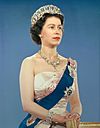 |
Elizabeth II (1926–2022) |
22 February 1979 | 8 September 2022 | Elizabeth Alexandra Mary | Philip Mountbatten | Windsor |
| Governors-General during her reign: Sir Allen Montgomery Lewis, Boswell Williams, Sir Stanislaus A. James, Sir George Mallet, Dame Pearlette Louisy, Sir Neville Cenac, Errol Charles (acting) Prime Ministers during her reign: Sir John Compton, Allan Louisy, Winston Cenac, Vaughan Lewis, Kenny Anthony, Stephenson King, Allen Chastanet, Philip J. Pierre |
||||||
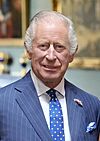 |
Charles III (b. 1948) |
8 September 2022 | present | Charles Philip Arthur George | Camilla Shand | Windsor |
| Governors-General during his reign: Sir Errol Charles Prime Ministers during his reign: Philip J. Pierre |
||||||
See also
- History of Saint Lucia
- Lists of office-holders
- List of prime ministers of Elizabeth II
- List of prime ministers of Charles III
- List of Commonwealth visits made by Elizabeth II
- Monarchies in the Americas
- List of monarchies


